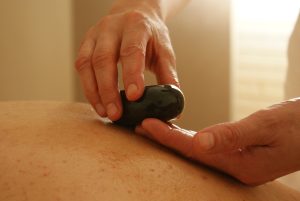Massage of soft tissues is both an art and a science, combining in a beneficial impact on the body and the soul of a person. This form of relaxation is becoming increasingly popular in the modern world, thanks to its numerous physical and emotional benefits.
Definition of Soft Tissue Massage:

Soft tissue massage is rightfully considered a therapeutic method based on the application of various soft and rhythmic movements to the body’s surface, including the skin, tendons, fascia, and muscles. It involves various techniques such as kneading, stretching, circular movements, as well as gentle pressure on the tissues, promoting improved blood circulation, muscle relaxation, tension and stress relief, and enhancing overall physical well-being.
This practice is widely used in medicine, sports rehabilitation, as well as in the field of health and wellness.
Benefits of Soft Tissue Massage:

- Relaxation and stress reduction: The rhythmic movements help reduce stress and anxiety.
- Improved blood circulation: Enhances blood flow, allowing tissues to receive more oxygen and nutrients.
- Pain and muscle tension reduction.
- Improved flexibility and mobility.
- Boosted immunity: Stimulates the immune system for more effective defense against infections and illnesses.
- Better sleep.
- Enhanced self-awareness and emotional comfort.
- Improved skin condition: Promotes better skin circulation, enhancing its appearance.
- Overall physical and emotional well-being.
Varieties of Soft Tissue Massage:

- Swedish Massage: Includes kneading, gentle pressure, stretching, and circular motions, aiming for overall relaxation and improved blood circulation.
- Deep Tissue Massage: Targets deeper muscle layers and tendons, potentially more intense, effective for chronic pain relief.
- Sports Massage: Specialized for athletes, focuses on maintaining and recovering muscles, helps prevent injuries, and speeds up post-exercise recovery.
- Thai Massage: Combines stretches and acupressure, enhancing flexibility, energy, relaxation of the body and mind.
- Neck and Shoulder Massage: Concentrates on the neck and shoulder area, where tension often accumulates, aiding muscle relaxation and pain relief.
- Face and Head Massage: Improves blood circulation and alleviates tension and headaches.
- Lymphatic Drainage Massage: Aims to enhance lymphatic circulation and toxin removal.
- Pregnancy Massage: Tailored relaxation for expectant mothers, reducing pregnancy-related discomfort and promoting relaxation.
- Pediatric Massage: Relaxing practices beneficial for improving sleep, reducing school-related stress, and supporting healthy development.
- Aromatherapy Massage: Utilizes essential oils to amplify relaxation and emotional well-being.
- Hydrotherapy: Uses water procedures like warm compresses or hot baths to enhance relaxation and circulation.
Massage Techniques for Soft Tissues:

Some fundamental techniques include:
- Effleurage: Gentle and continuous gliding of hands over the skin.
- Petrissage: Involves kneading, either with fingers, palms, or fists.
- Friction: Circular motions with fingers or palms applied to specific areas.
- Tapotement: Rhythmic tapping, often with fists, hands, or fingers.
- Stretching: Incorporates techniques to improve muscle and tendon flexibility.
- Acupressure: Applies pressure to specific points on the body.
- Trigger Point Work: Targets trigger points associated with pain.
- Lymphatic Drainage: Light movements for lymphatic circulation improvement.
- Aromatherapy: Combines massage with essential oils for enhanced relaxation and well-being.
- Hydrotherapy: Uses water in various ways to enhance the massage experience.
Tips for Choosing a Soft Tissue Massage Specialist:

- Check for licensing and certification.
- Assess experience and qualifications.
- Research the specialist’s reputation and read reviews.
- Ensure they have the relevant skills for your needs.
- Confirm adherence to hygiene standards.
- Opt for a personal consultation before the session.
- Seek a specialist who can adapt to your requirements.
- Compare prices and session duration.
- Consider location and convenience.
- Prioritize confidentiality.
Questions and Answers:
Are there contraindications for soft tissue massage?
Yes, contraindications include acute injuries, skin infections, vascular disorders, heart conditions, musculoskeletal diseases, pregnancy-related complications, and more. Consult with a healthcare professional if you have underlying medical concerns.
What is the typical duration of a soft tissue massage?
The duration varies based on individual preferences, health conditions, and goals. Relaxation massages usually last around 60 minutes, while more targeted or deep tissue massages might extend to 90 minutes or longer.
How does soft tissue massage differ from deep tissue massage?
While soft tissue massage and deep tissue massage are similar, they have some differences. Soft tissue massage generally focuses on the manipulation of the superficial layers of muscle and is less intrusive than deep tissue massage, which targets the deep layers of muscle.
What are the benefits of soft tissue massage?
Soft tissue massage helps to increase blood flow, reduce muscle tension, improve range of motion, relieve pain, and promote relaxation. It can also help in the treatment of various conditions, such as back pain, scar tissue, and stroke recovery.
How does soft tissue massage therapy work?
While soft tissue massage and deep tissue massage are similar, they have some differences. Soft tissue massage generally focuses on the manipulation of the superficial layers of muscle and is less intrusive than deep tissue massage, which targets the deep layers of muscle.
What are the benefits of soft tissue massage?
Soft tissue massage helps to increase blood flow, reduce muscle tension, improve range of motion, relieve pain, and promote relaxation. It can also help in the treatment of various conditions, such as back pain, scar tissue, and stroke recovery.
How does soft tissue massage therapy work?
During a soft tissue massage session, a therapist will use various techniques and approaches to apply pressure and manipulate the soft tissues of the body. This can include kneading, rubbing, stretching, and applying sustained pressure to release tension and promote healing.
Is soft tissue massage therapy suitable for everyone?
Soft tissue massage therapy is generally safe for most individuals. However, it is always recommended to consult with a qualified massage therapist or healthcare professional before undergoing any type of massage therapy, especially if you have any underlying health conditions or injuries.
What conditions can soft tissue massage therapy help with?
Soft tissue massage therapy can help with a wide range of conditions, including back pain, muscle tension, tendonitis, fibromyalgia, sports injuries, postural imbalances, and stress-related conditions. It can also be beneficial for promoting relaxation and reducing anxiety.
How often should I receive soft tissue massage therapy?
The frequency of soft tissue massage therapy sessions can vary depending on your specific needs and goals. Some individuals may benefit from regular sessions, while others may only require occasional treatments. It is best to discuss your individual needs with a qualified massage therapist to determine the appropriate frequency for you.
Are there any side effects of soft tissue massage therapy?
In general, soft tissue massage therapy is considered safe and has minimal side effects. However, you may experience some soreness or tenderness in the treated areas following a session, which is a normal response. It is also important to stay hydrated and rest after a massage to allow your body to heal and recover.













![11 Best Alternatives to Bedpage: Your Ultimate Guide [March 2024]](https://massage.dating/wp-content/uploads/2024/03/Best-Alternatives-to-Bedpage-300x200.jpg)
























































































































